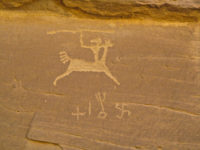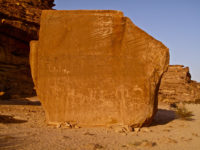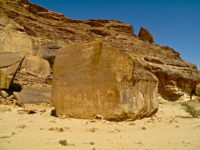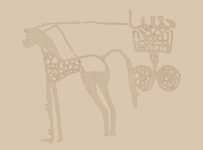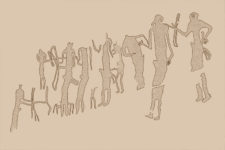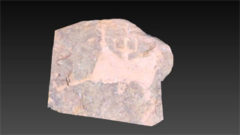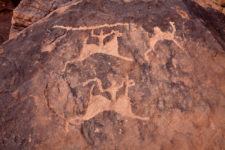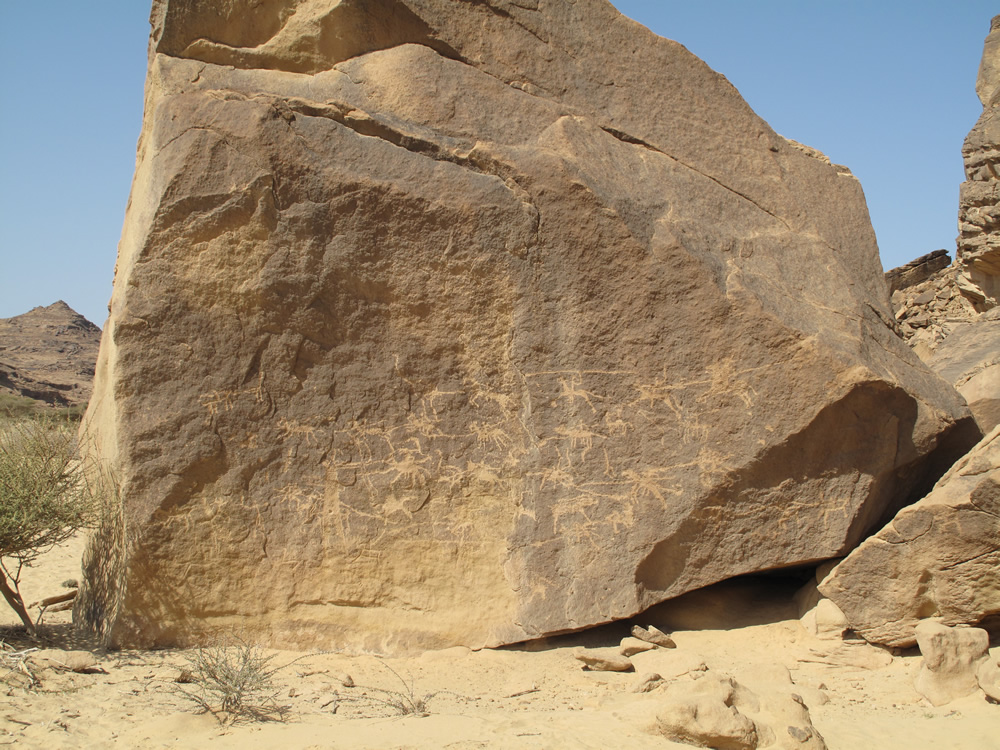 Interpersonal conflict is not obvious in Neolithic panels at Jubbah and Shuwaymis, where hunting scenes prevail. There is one panel done in the Neolithic style at Jubbah that we identify as the “Sentries” that shows two groups of men apparently confronting each other with bows. Alternatively, they may simply be gathering to prepare for a communal hunt. At Ghouwtah, the panel we call “Split Rock” shows small groups of people facing each other with something in their hands that could be weapons and shields. The people are not in the Neolithic style, but have more rounded bodies and are shallowly carved through the patina. They are also adjacent to writing and camels with similar patina, indicating that the humans probably date to around the first millennium BCE. There are a few isolated cavalrymen depicted at Jubbah, but nothing like the complex battle scenes in the south at Bir Hima.
Interpersonal conflict is not obvious in Neolithic panels at Jubbah and Shuwaymis, where hunting scenes prevail. There is one panel done in the Neolithic style at Jubbah that we identify as the “Sentries” that shows two groups of men apparently confronting each other with bows. Alternatively, they may simply be gathering to prepare for a communal hunt. At Ghouwtah, the panel we call “Split Rock” shows small groups of people facing each other with something in their hands that could be weapons and shields. The people are not in the Neolithic style, but have more rounded bodies and are shallowly carved through the patina. They are also adjacent to writing and camels with similar patina, indicating that the humans probably date to around the first millennium BCE. There are a few isolated cavalrymen depicted at Jubbah, but nothing like the complex battle scenes in the south at Bir Hima.
After the Neolithic, in the north, small numbers of chariots appear in the rock art. The earliest depictions, like the one at Jubbah, are very similar to ones found across the Eurasian steppe, particularly in Central Asia, and may indicate the earliest source of chariots in Arabia. The style for showing these horse drawn vehicles looks like an aerial view with the wheels taken off and lying flat. The two horses are also recumbent and typically back-to-back. One image shows the two horses facing each other. The wheels all have four spokes, which was typical of early lightweight chariots designed to convey just one man. Our investigation located only one chariot image actually showing a man in it, however. If these chariots are comparable to those in the Eurasian steppe, they probably date to the first half of the second millennium BCE. It is not clear from the individual, isolated figures that the chariot was used militarily in Saudi Arabia initially.
In the regions around Tayma, al Ula, and Ha’il, there are chariots depicted in a different style and probably from a later date, perhaps between 1500-200 BCE. These images are shown in the more typical way, in profile, as the Egyptians, Assyrians, Persians, Greeks, and others did. The illustrations are all distinctive, without much standardization beyond the profile view. There are always two horses, but the box, its position, the number of spokes, wheel construction, and the number of men (1-3) are highly variable and often not very realistic. In one case, the spokes do not continue from the hub to the rim; instead there are two sets of spokes, one that runs from the hub to halfway out and a second that runs from halfway out to the rim. These wheels look more like ones used at wells to pull the water out. The horses also sometimes look unrealistic. One wonders how familiar the artists were with the actual vehicles or the animals that pulled them. Horses were quite rare before the days of the cavalry, prior to around 800 BCE, and chariots would have been poorly suited for the deep sand or rocky surfaces of the Arabian desert.
The only chariot image that specifically depicts military use is at Hafrat Berd, where two of the three men in the chariot box are wielding weapons. The man in front appears to have a sword and the man in back may have a bow. There are also numerous panels with men riding Arabian horses in the north, but typically alone, rather than in conflict with others.
The crowded panel at Qaryat al Asba (Graffiti Rocks), in central Saudi Arabia, has infantrymen fighting and some cavalry.
There is relatively little warfare depicted in rock art outside of the southwestern part of the country and only there in later times. In panels made during the last half of the first millennium BCE to the first half of the first millennium CE, in the Bir Hima area, battle scenes are actually the dominant themes. The numerous panels reveal many important aspects of how war was waged, including that it was fought by infantrymen, cavalrymen, and cameleers. A wide variety of weapons is clearly illustrated, including sabers, swords, large curved knives, and extremely long lances, all used by both mounted and foot soldiers. Some armour is shown on the men, including helmets and cuirasses. Dots around the bodies of some horses suggest equine armour, as well. Dating the battle scenes could be refined once the weaponry and the associated text and are studied carefully.
The battle scenes in the Bir Hima region are often accompanied by females with long braids standing with their arms raised in the air. These have been called Aliat goddesses, after the goddess Al-Lat, one of the three chief goddesses of pre-Islamic Arabia, along with Al-Uzza and Menat. They were worshipped from the Nabataean capital of Petra, in Jordan, to the Sabean culture of current Yemen in southern Arabia, to Iran. Al-Lat simply means the Goddess, or daughter of Al-Lah. She was associated with springtime and fertility, and was the Earth Goddess, often symbolized by the crescent moon or the sun resting in the crescent moon. As tempting as it is to refer the females depicted on so many panels in Bir Hima to Al-Lat, there is no definite confirmation of this.
The repeated close association between the female figures and warfare on the Bir Hima panels is perhaps in stronger accordance with Al-Uzza, the “Most Mighty,” or virgin warrior, as she is considered protective of armies preparing to go into battle. Al-Uzza functioned as a war goddess, representing confidence, vigilance, and preparation. She was the Mistress of Heaven in the Nabataean zodiac and the chief pre-Islamic goddess. However, she was originally Sabean, and her origin in South Arabia could explain why these particular female images are concentrated in Yemen and southwestern Saudi Arabia.
Interestingly, the qasida poets, members of the pre-Islamic warrior elite, combined the concepts of fertility, war and destruction, (Montgomery 2006, p. 96), therefore enabling the goddesses Al-Lat and Al-Uzza to be conflated into one. This could explain the appearance of the female images, as well as their link to military scenes. Some scholars have argued that Petra Al-Lat and Al-Uzza are two names for the same deity.
Reference:
Montgomery, James E. 2006
The Empty Hijaz, in J.E. Montgomery (ed.) Arabic Theology, Arabic Philosophy: From the Many to the One. Essays in Celebration of Richard M. Frank. Orientalia Lovaniensia Analecta. Peeters Publishers, Louvain, Belgium. Pp. 37-100.

